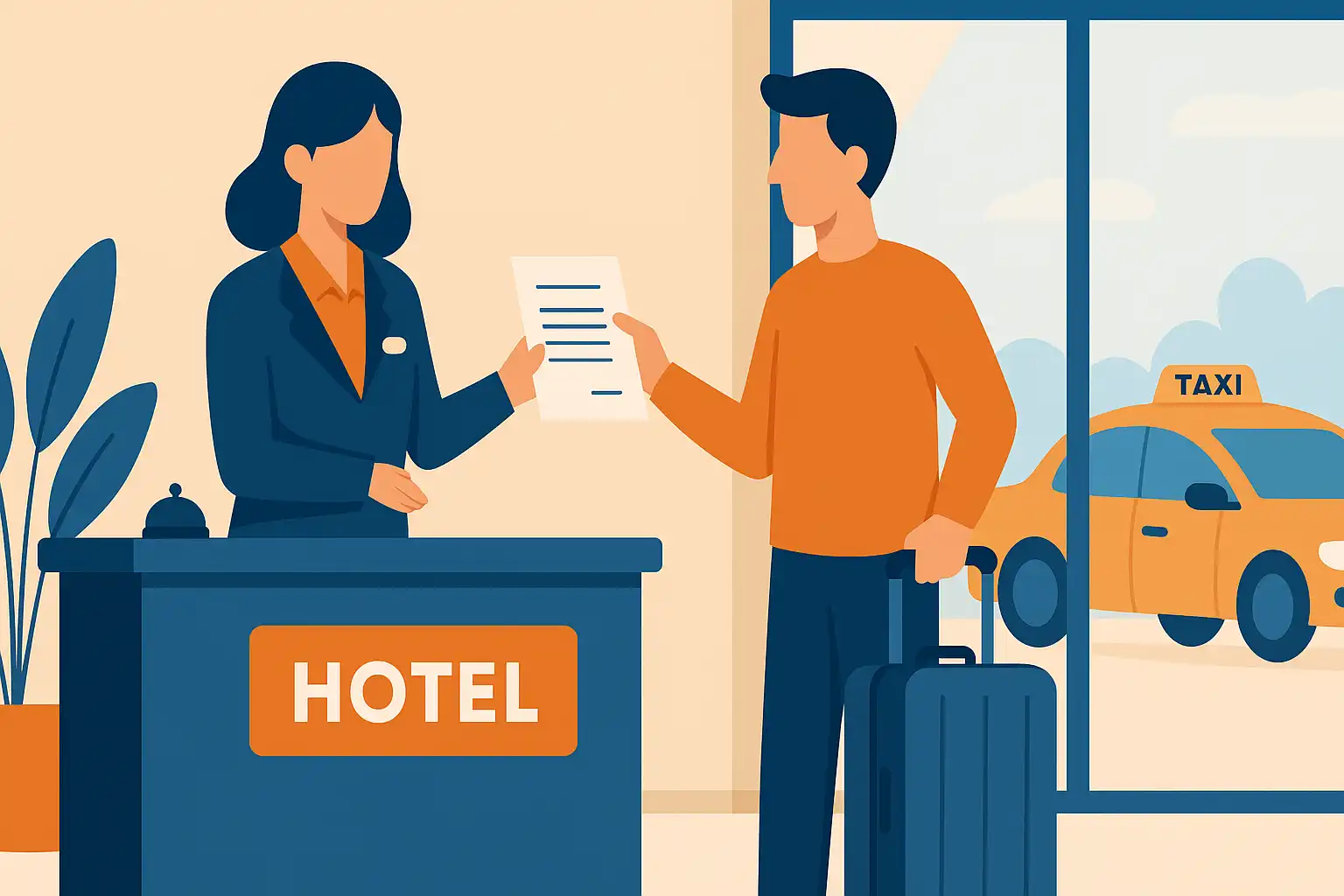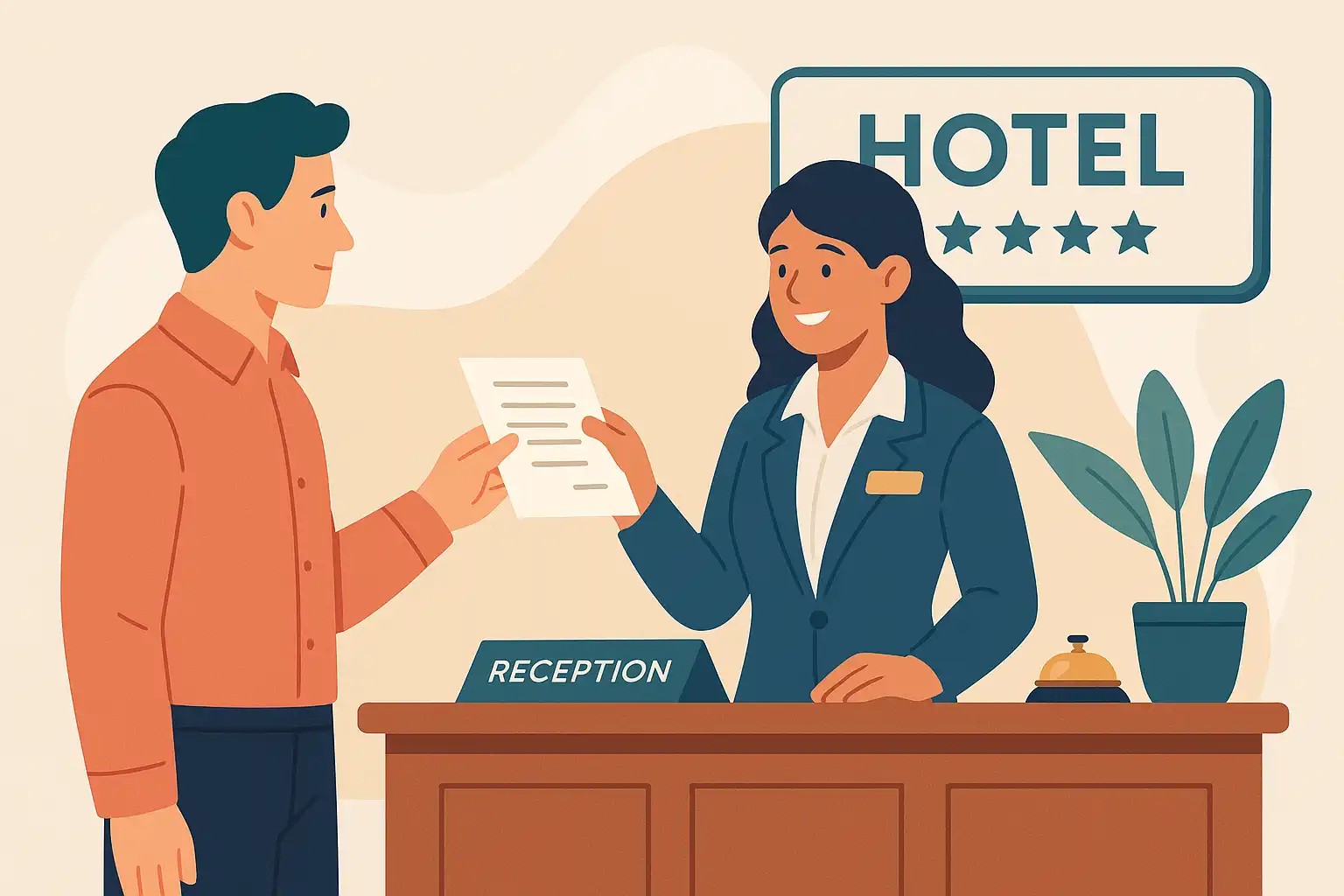Hotel Walk Letter Template: Professional Guest Communication
Sep 26, 2025
 Mika Takahashi
Mika TakahashiPopular Categories
Hotel Technology & InnovationHotel Operations OptimizationDigital MarketingIndustry TrendsRevenue ManagementHospitality Industry
Popular Categories
Trending Post

Hotel Walk Letter Template: Professional Guest Communication

Online Travel Agents: What They Are and How They Work

Hotel Security Systems: Modern Protection Solutions

Hotel Advertising: Complete Guide to Boost Bookings and Revenue

25 Hotel Marketing Strategy Ideas for 2025: Complete Guide

AI Reservation Agent: Revolutionizing Hotel Booking and Guest Experience

PMS Communication: Streamlining Property Management Through Effective Guest Messaging
Table of contents
Every hotel manager knows the sinking feeling of having to tell a guest their reserved room just isn’t available. Whether it’s due to overbooking, emergency repairs, or some unexpected hiccup, these moments are tricky to handle. That’s where a hotel walk letter comes in—a formal document that helps smooth over the situation and keeps guest trust intact.
In hospitality, how you communicate during these tough times can turn a potential disaster into a chance to show your dedication to great service. This guide will walk you through everything you need to know about crafting, customizing, and delivering professional hotel walk letters that help keep guests happy, even when things don’t go as planned.
What Is a Hotel Walk Letter?
A hotel walk letter is the official note you give guests when you can’t honor their reservation at your property and need to arrange a stay for them somewhere else. It’s more than just a heads-up—it’s a key tool that protects your hotel legally and shows respect for your guest’s time and expectations.
This hotel walk letter acts as proof of your efforts to accommodate guests despite challenges, ensuring transparency and professionalism. Used when guests are “walked” to an alternate hotel due to full capacity or operational issues, the letter can make all the difference between a frustrated guest and a loyal one.
Experts agree: a well-written hotel walk letter can actually strengthen guest relationships when handled with care. It’s all about seeing this document not as a burden but as a vital opportunity to reflect your hotel’s commitment to excellent service.

When Should Hotels Issue Walk Letters?
Knowing when to send a hotel walk letter helps your team prepare the right response and gather all necessary details before the guest arrives. Quick and clear communication is key to easing guest frustration.
The most common reason? Overbooking. During busy times like holidays, summer vacations, or big local events, hotels sometimes sell more rooms than they actually have, betting some guests won’t show up. But when more guests arrive than expected, you need to arrange alternative accommodations quickly.
Emergency maintenance is another reason for issuing a hotel walk letter. Sudden plumbing leaks, HVAC failures, or electrical issues can make rooms unusable at a moment’s notice. In these cases, guest safety is the priority, and swift action is essential.
Sometimes rooms get damaged last-minute by previous guests, forcing hotels to pull them from availability. Construction delays or safety concerns can also mean certain rooms aren’t ready or safe to use, requiring professional communication with affected guests.
Studies show that walk rates hover around 1-3% during peak occupancy, spiking during major events or unexpected issues. Hotels that handle these situations well often see better guest satisfaction compared to those that don’t.
Essential Components of an Effective Walk Letter
Writing an effective hotel walk letter means paying close attention to both what you say and how you say it. Each part of the letter plays a role in keeping guest goodwill while protecting your hotel.
Start with a sincere apology. This sets the tone and shows you genuinely regret the inconvenience. Avoid generic, robotic wording that sounds like a copy-paste. Instead, personalize your apology to acknowledge the guest’s specific situation.
Next, clearly explain what’s going on without blaming anyone or getting too technical. Guests appreciate straightforward, honest information that helps them understand the situation without feeling like they’re getting excuses.
Then, provide all the details about the alternate accommodation: hotel name, address, contact info, room type—everything they need to feel comfortable and confident about the change.
Don’t forget transportation details. Whether you’re offering free shuttles, taxi vouchers, or simple directions, this shows you’re thinking about their convenience and comfort.
Goodwill compensation is important too. Whether it’s meal vouchers, room upgrades at the new hotel, future stay credits, or other perks, compensation helps soften the blow and shows you value the guest’s experience.
Finally, include direct contact info for someone they can reach if they have questions or concerns. Personal contact details, not just a generic front desk number, make guests feel supported.
Professional Tone and Language Guidelines
The language in your hotel walk letter really shapes how guests feel about the situation. Aim for empathy balanced with professionalism.
Use phrases like “we understand your disappointment” or “we sincerely regret this inconvenience” to show you care without admitting unnecessary liability.
Keep the tone formal but friendly—avoid slang or overly casual phrases, but also steer clear of dry legal jargon that can feel cold.
Make sure to include all relevant dates, times, and reservation numbers for clarity. This attention to detail reassures guests that you’re handling their case carefully.
Here’s an example: “We sincerely apologize for the unexpected circumstances requiring us to arrange alternative accommodation for your stay on [specific dates]. Due to unforeseen maintenance, we have secured a comparable room at [alternate hotel] and will cover all associated costs.”
Hotel Walk Letter Templates and Customization
Using standardized hotel walk letter templates ensures your messaging stays consistent and professional no matter who’s handling the situation. These templates are a lifesaver when time is tight and emotions run high.
The benefits? Consistent communication that protects your brand, faster response times, and easier training for your front desk team. Templates also help keep you compliant with legal standards and maintain professionalism, even with less experienced staff.
Make sure your hotel walk letter template includes fields for guest names, reservation details, dates, alternate hotel info, and compensation offers. Fillable forms let staff quickly personalize each letter without losing that important personal touch.
Customization is key. You might want different templates for overbooking versus maintenance issues, or special versions for loyalty program members who deserve extra perks.
Don’t forget brand alignment. Your hotel walk letter templates should reflect your hotel’s look and tone—letterhead, colors, and style should all match your other guest communications to reinforce your professionalism.
Consider how you deliver these letters too. Digital templates should be optimized for email and mobile viewing, while printed versions might need a different layout for face-to-face delivery.
How to Create and Edit Walk Letter Templates
Start by reviewing common walk scenarios at your hotel and drafting language that fits your brand voice.
Include variable fields for guest names, check-in dates, reservation numbers, alternate hotel details, and compensation. This makes it easy for staff to quickly customize each letter.
Have your legal team review templates to ensure compliance with local laws and industry standards. Update templates regularly to keep them current.
Train your staff thoroughly on when and how to use each hotel walk letter template, how to personalize them, and the best delivery methods. Practice makes perfect, especially for handling sensitive guest conversations.
Many hotels use platforms like Google Drive for easy access, editing, and version control of their hotel walk letter templates. This keeps everyone on the same page and safeguards your documents.

Best Practices for Delivering Walk Letters
When and how you deliver a hotel walk letter can make a big difference in guest satisfaction.
Timing is everything. Whenever possible, send the letter before the guest arrives so they can adjust their plans. If that’s not an option, deliver it immediately upon arrival to show respect for their time.
For in-person delivery, train your front desk staff to communicate clearly and empathetically. They should be ready to answer questions and help guests with alternative arrangements.
Email works well for advance notices but pay attention to subject lines—something like “Important Update Regarding Your Reservation” grabs attention. Include all necessary details and contact info.
Follow up with guests after they’ve checked into the alternate hotel to make sure everything’s going smoothly. This extra step can prevent negative reviews and build goodwill.
Keep detailed records of all walk letter communications and compensation. This protects your hotel and provides proof if any disputes arise.
Prepare your staff for all kinds of guest reactions. Role-playing difficult conversations helps build confidence and ensures a calm, empathetic response.
Hotel Walk Letter Template
[Hotel Logo / Letterhead]
Date: [Insert Date]
Dear [Guest Name],
We sincerely apologize that we are unable to accommodate your reservation at [Hotel Name] for the night of [Reservation Date] due to [unexpected overbooking / operational reasons]. We truly value your patronage and regret this inconvenience.
To ensure your comfort, we have arranged alternate accommodations at:
Hotel: [Name of Alternate Hotel]
Address: [Hotel Address]
Phone: [Hotel Phone Number]
Your new room is confirmed and prepaid for tonight. In addition, we are pleased to offer you the following as a gesture of goodwill:
- Transportation: Complimentary transfer to the alternate hotel
- Rate Protection: The room rate will remain the same as your original booking with us
- Additional Compensation: [e.g., Complimentary dinner / future discount / reward points / voucher for a free stay at our hotel]
Please accept our deepest apologies for this disruption to your travel plans. We greatly value your loyalty and hope to welcome you back to [Hotel Name] on your next visit.
If you have any questions or require further assistance, please contact me directly at [Manager’s Phone / Email].
Thank you for your understanding.
Sincerely,
[Manager’s Name]
[Title]
[Hotel Name]
[Contact Information]
Legal Considerations and Compliance
Knowing the legal side of guest displacement helps protect your hotel and ensures fair treatment for guests.
Check local and state laws about minimum compensation and guest rights in these situations. Make sure your hotel walk letter templates and procedures meet or exceed these requirements.
Document all compensation and alternative arrangements carefully to maintain transparency and protect against claims.
Understand your hotel’s obligations to provide comparable accommodation, reasonable compensation, and professional communication throughout the process.
Review your insurance policies to see what costs might be covered when guests are walked.
Consult with hospitality law experts to develop and regularly update your walk procedures for ongoing compliance.
Protecting Brand Reputation Through Walk Letters
Handled well, hotel walk letters are a powerful way to protect your brand and build guest loyalty. How you manage these tough moments often shapes long-term guest relationships and online reputation.
Prevent negative reviews by communicating proactively and offering compensation that goes beyond what guests expect. Many hotels find that guests who receive great service during a walk become even more loyal.
Exceptional service recovery shows your company’s values and dedication to guest satisfaction. When guests feel heard, respected, and fairly compensated, they often develop a stronger connection to your brand.
Keep social media in mind—guests who feel well treated rarely post complaints online, while those who feel ignored often share their frustrations publicly.
Train your front desk team on hotel walk letter procedures and guest recovery techniques to ensure consistent, positive brand representation.
Gather feedback from guests who experience walks to improve your process and celebrate what’s working.
Research shows hotels with solid walk procedures and generous compensation often maintain higher guest satisfaction than those that handle walks poorly.
Common Mistakes to Avoid
Avoid these pitfalls to keep your hotel’s reputation intact:
- Using generic language that feels impersonal and scripted.
- Offering too little compensation, which can lead to bad reviews.
- Delivering walk letters too late, giving guests little time to adjust.
- Failing to follow up after the initial letter.
- Not training staff well enough to handle sensitive situations.
When done right, hotel walk letters turn challenges into opportunities to show exceptional care.
Conclusion
Managing hotel walk letters professionally is a crucial skill that sets outstanding hotels apart. Thoughtfully crafted and delivered walk letters turn potentially negative situations into moments of genuine guest care.
Treat each hotel walk letter as a chance to demonstrate your values, offer sincere apologies, provide generous compensation, and communicate proactively. This approach helps preserve your brand’s reputation even during the most challenging times.
Remember, every hotel walk letter reflects your hotel’s character and professionalism. Invest in developing comprehensive templates, train your team well, and establish procedures that put guest satisfaction first. When you get these communications right, your hotel gains a competitive edge in the crowded hospitality market.
Start today by reviewing your current walk letter process, updating your templates, and empowering your team to handle walk situations with confidence and care. Your guests—and your brand—will thank you.
